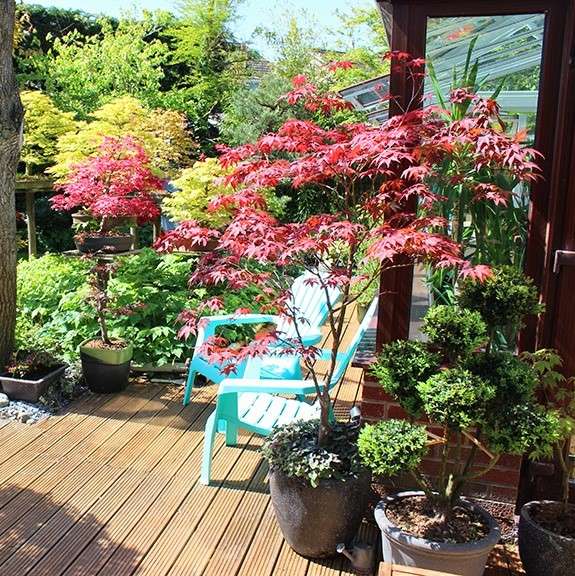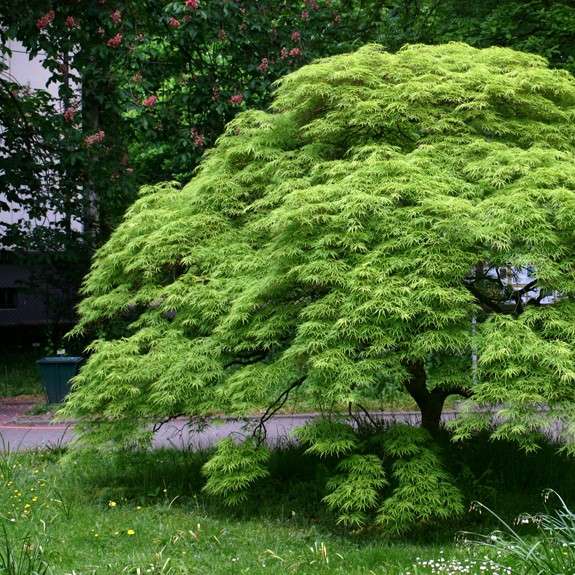
Japanese Maples

Caring For Your Japanese Maple
Japanese Maples are a garden favorite because of their graceful and elegant branching habit. Available in a variety of sizes and forms, including upright, weeping, broadleaf, and laceleaf, they provide year-round interest—from bare branches in winter, to new spring growth that can be green, red, pink, variegated, serrated, or lace-like, followed by vibrant summer growth, and always beautiful fall color.
Read on for care guidelines covering Sun Tolerance, Watering, Soil, Amendment & Fertilizer, and Pruning. As always, our garden gurus are on-hand to answer questions or provide guidance for your unique planting situation.
Read on for care guidelines covering Sun Tolerance, Watering, Soil, Amendment & Fertilizer, and Pruning. As always, our garden gurus are on-hand to answer questions or provide guidance for your unique planting situation.
Sun Tolerance
While most varieties of Japanese Maples will not thrive in full sun in our climate, some can adapt to sun over time. Varieties with broader leaves tend to adapt best; generally, laceleaf varieties don’t fare as well. The key to successful adaptation is sufficient irrigation, along with a thick layer of mulch to blanket the roots away from the trunk.
We recommend planting in the spring, fall or winter for best results. Additionally, selecting varieties that are better adapted to our climate will help ensure that your tree thrives in its new environment: ‘Bloodgood’, ‘Emperor’, ‘Seiryu’ and Acer palmatum ‘Seedlings’ are all good choices for our area. New trees acclimating to the sun may show signs of sunburn on the outer leaves for the first few years.
Tip: When the Sacramento heat is unbearable, an application of Bonide® Wilt Stop® can help your Japanese Maple adapt to the afternoon sun by creating a protective barrier, slowing water loss through leaves.
We recommend planting in the spring, fall or winter for best results. Additionally, selecting varieties that are better adapted to our climate will help ensure that your tree thrives in its new environment: ‘Bloodgood’, ‘Emperor’, ‘Seiryu’ and Acer palmatum ‘Seedlings’ are all good choices for our area. New trees acclimating to the sun may show signs of sunburn on the outer leaves for the first few years.
Tip: When the Sacramento heat is unbearable, an application of Bonide® Wilt Stop® can help your Japanese Maple adapt to the afternoon sun by creating a protective barrier, slowing water loss through leaves.

Watering
Japanese Maples have very delicate leaves, with thin branches, meaning water doesn’t move very quickly up from the roots, and their leaves will show damage if the soil becomes too dry. A 2"-4" layer of mulch around the roots slows the evaporation of water in the soil, keeping the roots cool and moist. To avoid crown rot, keep the mulch a few inches away from the trunk of the tree.
The frequency of watering a Japanese Maple depends on:
The frequency of watering a Japanese Maple depends on:
- Soil texture
- Sun exposure
- Wind exposure
- Size of the tree
- Season
There is no single answer on how many times per week you should water your Japanese Maple, because it varies so much depending on the factors listed above. However, it is always a good idea to water deeply, yet infrequently. Each time you water, thoroughly penetrate the root zone, and give the water a chance to evaporate out of the soil before watering again. Reapply once the top 2"-3" of soil begins to dry out. Drought tolerance increases with age.

Soil, Amendment & Fertilizer
Japanese Maples prefer soil that is slightly acidic, well-draining, with a good amount of organic matter. They can adapt to other soil types, but they will not tolerate wet, dry or very alkaline conditions. E.B. Stone™ Organics Azalea, Camellia & Acid Planting Mix can be used as both a soil amendment or as a ready-to-use potting soil. It is a special blend of organic ingredients designed to meet the unique growing needs of most acid-loving plants.
Newly planted Japanese Maple trees do not require fertilizer during the first year in their new location. After the first year, young trees can be fertilized regularly for three years to promote development of the root system. Mature Japanese Maples do not always need to be fertilized because they have an extensive root system. We recommend that you watch for changes in growth patterns like branch development and leaf size, and feed, as needed. Fox Farm Happy Frog Japanese Maple uses a lower-nitrogen formula 4-3-4 resulting in less leaf scorch in summer, even in sun, and a smooth transition to fall color.
Newly planted Japanese Maple trees do not require fertilizer during the first year in their new location. After the first year, young trees can be fertilized regularly for three years to promote development of the root system. Mature Japanese Maples do not always need to be fertilized because they have an extensive root system. We recommend that you watch for changes in growth patterns like branch development and leaf size, and feed, as needed. Fox Farm Happy Frog Japanese Maple uses a lower-nitrogen formula 4-3-4 resulting in less leaf scorch in summer, even in sun, and a smooth transition to fall color.

Pruning
Japanese Maples have a naturally graceful growth habit. Accentuate their natural beauty by thinning to allow light into the canopy, and avoid “heading” or “shearing” cuts. Each year, remove any dead branches or branches that are crossing. It’s always better to prune off a branch while it is small than it is to prune a large branch; it will leave a smaller wound. Avoid early heavy pruning if you would like your maple to acclimate to the sun.
The tree will need as much energy as it can get from its leaves to build its sun tolerance. The best time to prune is in late winter, before the tree leafs out. Because it is still dormant, this will reduce shock, and without leaves you can see the structure of the tree more clearly.
The tree will need as much energy as it can get from its leaves to build its sun tolerance. The best time to prune is in late winter, before the tree leafs out. Because it is still dormant, this will reduce shock, and without leaves you can see the structure of the tree more clearly.

